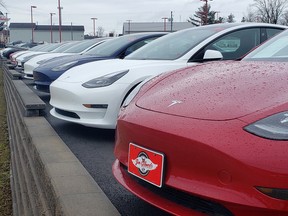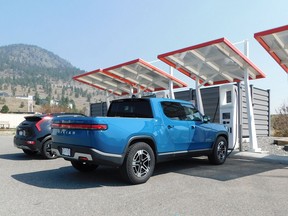
As automakers continue to delay their electric-vehicle plans and report lower-than-expected sales, Canada’s goal of ensuring that at least 20 per cent of new vehicles sold by 2026 are electric seems to be in jeopardy.
Ford Motor Co. last week said it was going to delay EV production at its assembly plant in Oakville, Ont., by two years to 2027 from 2025. The additional time will allow the company to take advantage of an emerging battery technology and let the number of consumers grow.
Earlier this month, Tesla Inc. reported a decline in quarterly deliveries for the first time in nearly four years. The Elon Musk-led company attributed the fall to logistical issues, but analysts say that slowing demand for EVs also played a role.
General Motors Co.’s chief executive Mary Barra referred to this slowdown as well on an earnings call in January, when she said the slowing pace of EV growth had created some uncertainty. She still expects EV sales in 2024 to improve, but said “if demand conditions change, we’ll take advantage of our manufacturing flexibility … to build more internal combustion engine models and fewer EVs.”
Why is demand slowing?
The number of zero-emission vehicles (ZEVs) has been increasing, according to new vehicle registrations in Canada. In 2023, ZEVs accounted for about 10.8 per cent of all such registrations, according to Statistics Canada, nearly a 50 per cent increase from 2022 and a 114.6 per cent increase compared to 2021.
The EV market seems to be facing challenges moving from early adopters to the mass market. Karwel describes early adopters as consumers who were not necessarily concerned about the cost of an EV, but wanted to be associated with the “newest, coolest and latest technology.”
As such, the sale of luxury EVs has been doubling every year over the past five years, he said. These are bought by wealthier customers who tend to own a house and a garage, so they don’t face any issues charging their vehicles.
But the market now seems to be looking for more general buyers at a mass level, which has proven to be difficult for several reasons, including high prices and poor performance.

Another major issue is the lack of charging stations.
“Now you are going after customers who only have one vehicle. They use this vehicle for all their needs and they perhaps have significant driving distances to cover,” said Brian Kingston, chief executive of the Canadian Vehicle Manufacturers’ Association, which includes companies such as Ford and General Motors. “That customer is harder to bring to electric because they look out right now and they ask: Where is the charging infrastructure?”
For the federal government to reach its target of building a total of 442,000 public chargers by 2035, 100 new public chargers need to come online every day, he said.
“Just imagine if nearly half of the Canadian driving population reported gas station outages,” Kingston said. “That would be considered a national crisis.”
While charging is an issue, Karwel’s data suggests Canadians are more concerned about prices. On average, an EV costs about $15,000 more than a gas-powered car before any government incentives are applied. This increases to $20,000 if customers compare “apples to apples” and look to buy specific EV versions of their existing gas-powered cars, he said.
Add to this the high-interest rate environment and the current housing market, and it’s a “tall order to ask the average Canadian” to buy an EV, Karwel said.
What is the future of EVs?
Despite the slowing demand, industry insiders are confident that EV sales will continue to grow, but the pace will slow. That will make it difficult for Canada to meet its immediate goal of ensuring that at least 20 per cent of its new vehicles sold by 2026 are electric, both Karwel and Kingston say.
Kingston is worried that some existing government incentives may not be renewed in the near future and that could negatively impact EV sales. For example, the federal government’s Incentives for Zero-Emission Vehicles (iZEV) program offers up to $5,000. But the “extremely popular” program may run out of funds by 2025, Kingston said.
Similarly, Quebec has announced it will be ending its provincial incentive program by 2027.
With these factors in mind, the Canadian Vehicle Manufacturers’ Association wrote to Finance Minister Chrystia Freeland and urged the federal government to announce stronger support for EVs in the upcoming budget.
The association recommended increasing the incentives for ZEVs to $10,000 per vehicle. The letter also noted that Canada will need to spend more than $50 billion on chargers in the next 11 years to adequately support the transition towards electric cars.
Karwel pointed out that an EV is competing with technology that took about 110 years to perfect.
Overall, analysts expect EVs to gradually penetrate the market, but they don’t foresee a smooth trip and expect more automakers to delay their EV plans.
“The pick up of the EV is going to be in a situation where we are going to take three steps forward and two steps back,” Karwel said. “EV sales will grow. But it’s not going to be as aggressive as it was in the past two years.”
• Email: [email protected]
Share This:



